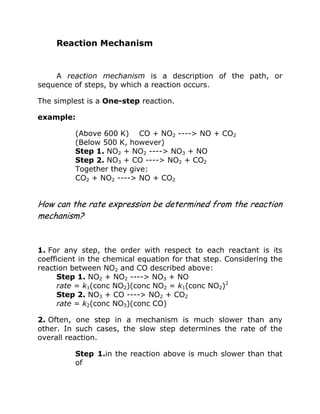Reaction mechanism
- 1. Reaction Mechanism A reaction mechanism is a description of the path, or sequence of steps, by which a reaction occurs. The simplest is a One-step reaction. example: (Above 600 K) CO + NO2 ----> NO + CO2 (Below 500 K, however) Step 1. NO2 + NO2 ----> NO3 + NO Step 2. NO3 + CO ----> NO2 + CO2 Together they give: CO2 + NO2 ----> NO + CO2 How can the rate expression be determined from the reaction mechanism? 1. For any step, the order with respect to each reactant is its coefficient in the chemical equation for that step. Considering the reaction between NO2 and CO described above: Step 1. NO2 + NO2 ----> NO3 + NO rate = k1(conc NO2)(conc NO2 = k1(conc NO2)2 Step 2. NO3 + CO ----> NO2 + CO2 rate = k2(conc NO3)(conc CO) 2. Often, one step in a mechanism is much slower than any other. In such cases, the slow step determines the rate of the overall reaction. Step 1.in the reaction above is much slower than that of
- 2. Step 2, so the rate of the overall reaction is that of the first step. rate = k1(conc NO2)2 Experimentally, at low temperatures, the reaction between CO and NO2 is 2nd order with respect to NO2 and zero order with respect to CO. At high temperatures, the reaction is actually single step and is first order in NO2 and CO. 3.The final rate expression must include only those species that appear in the balanced equation for the overall reaction. Reactive intermediates must be eleminated from the rate expression. example Step 1. NO + Cl2 <----> NOCl2 (fast) Step 2.NOCl<sub.2< sub=""> + NO ----> 2NOCl (slow) Together they give: 2NO + Cl2 ----> 2NOCl NOCl2 is an unstable intermediate in equilibrium with NO and Cl2. An NOCl2 molecule reacts with another molecule of NO in a slow rate-determining step. </sub.2<> rate= k(conc NOCl2)(conc NO) prepared by; Michael G. Arpon
- 3. Purpose; ïķ To know what is reaction mechanism. ïķ Importance of knowing reaction mechanism. ïķ To know the occurrence of reaction mechanism in each elements.



